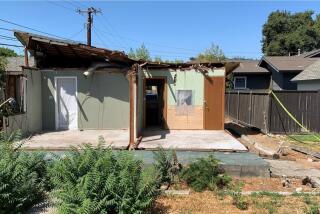Santa Paula School District Looking for Good Home for Home
- Share via
SANTA PAULA — Needing to free up land around its headquarters, the Santa Paula Elementary School District wants to give away a 120-year-old house believed to have served as one of the city’s original schools.
Known as the Moultrie house, the Victorian farmhouse sits abandoned behind the district’s main office. The district says it will give the condemned four-bedroom house to anyone who will move it by or around Dec. 1.
“We’d like to see it maintained as an example of an early farmhouse,” Assistant Supt. Randy Chase said. “A few people were interested, but their interest has fallen through.” Santa Paula historian Judy Triem said the oldest parts of the house date to 1870, when the Elijah Boor family moved in.
“He was a schoolteacher in this area in the 1870s and 1880s, and it was said that classes were held in this house before the first school was built in Santa Paula,” said Triem, who has researched the history of Moultrie house and chairs the city’s design assistance committee. She and the committee would like to see the house preserved.
Steckel Road, where the house and the district headquarters sit, was originally called Boor Road, Triem said. Boor was also the superintendent of the Santa Paula Cemetery Assn.
“In those days, there wasn’t that much out there except the farm and the cemetery,” she said.
The Boor house became the Moultrie house after Tennessee transplant William W. Moultrie bought it in 1906. By that time, the house’s two-story bay front had been added.
When the Moultries owned it, the house sat on 13 acres of apricot trees. In 1918, Triem said, the family bought four more acres to grow walnuts.
Moultrie’s son, 91-year-old Randolph Moultrie, remembers planting an avocado tree that now stands as tall as the house and still drops avocados into the frontyard.
“It wasn’t too big when I was here,” said Moultrie after visiting his former home recently. He lived there from 1917 until he got married in 1938 and moved out. Moultrie’s older sister, Eulyce, lived in the house until her death in the 1980s.
Moultrie said his sister, who was a teacher, was known around town as “a stinker--no question about it.”
“She had everybody in town mad at her,” he added. Moultrie said he rarely visited the house after his mother died, and has no problem with the school district getting rid of it.
“I think the best thing to do is give it to the Fire Department and let them practice on it,” he said.
But the school district is intent on trying to save the house.
After buying Moultrie house and surrounding land from Citrus Exchange last year, the school district considered ways to keep the house for its own needs, Supt. Bonnie Bruington said. But the rooms were too small and its structure too unstable for it to hold students.
The cost and time necessary to renovate the house to bring it up to meet building code are prohibitive.
“We talked about it, but there was just no way we could do it,” Bruington said.
To look at the Moultrie house, it would not appear worth saving. Its doors and windows are boarded up. The wooden steps and porch are splintered and rotting. And the house’s light fixtures and doorknobs have been stolen.
Despite its dilapidated condition, Bruington said the house is unique, and hopes it will be saved.
“It is my understanding that it is the only example of a Victorian farmhouse that we have in this area,” she said.
“It’s not a real fancy house,” Triem added, “but it’s more typical, I think, of farmhouses from the 1880s or ‘90s.” She calls its style “folk Victorian.”
A few people have expressed interest in the house, but all of their plans have fallen through.
Steve and Pam Colvard were among those who had plans for the house. They wanted to move it downtown and turn it into a gift shop and restaurant, but like the school district, they were dissuaded by the cost of moving the house and bringing it up to code.
At this point, the district will gladly give the house to anyone who promises to take care of it, Bruington said. The district needs the space for extra classrooms.
There’s only one catch: “It has to be someone who will take all of it,” Bruington said.
More to Read
Sign up for Essential California
The most important California stories and recommendations in your inbox every morning.
You may occasionally receive promotional content from the Los Angeles Times.













